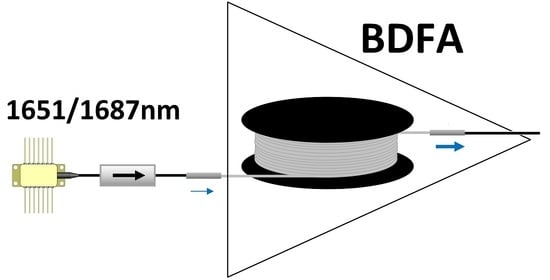Operation of a Single-Frequency Bismuth-Doped Fiber Power Amplifier near 1.65 µm
Abstract
1. Introduction
2. Materials and Methods (Experimental Setup)
2.1. 1.55 µm Pump Source
3. Results
3.1. SBS Suppression with the New Pump Source
3.2. BDFA Performance
3.3. Photothermal Spectroscopy Using a BDFA-Amplified Source
4. Discussion
Author Contributions
Funding
Conflicts of Interest
References
- Crotti, C.; Deloison, F.; Alahyane, F.; Aptel, F.; Kowalczuk, L.; Legeais, J.-M.; Peyrot, D.A.; Savoldelli, M.; Plamann, K. Wavelength optimization in femtosecond laser corneal surgery. Investig. Ophthalmol. Vis. Sci. 2013, 54, 3340–3349. [Google Scholar] [CrossRef]
- Qin, Y.; Batjargal, O.; Cromey, B.; Kieu, K. All-fiber high-power 1700 nm femtosecond laser based on optical parametric chirped-pulse amplification. Opt. Express 2020, 28, 2317–2325. [Google Scholar] [CrossRef]
- Zhang, E.J.; Teng, C.C.; van Kessel, T.G.; Klein, L.; Muralidhar, R.; Wysocki, G.; Green, W.M.J. Field deployment of a portable optical spectrometer for methane fugitive emissions monitoring on oil and gas well pads. Sensors 2019, 19, 2707. [Google Scholar] [CrossRef]
- Tian, X.; Cao, Y.; Chen, J.; Liu, K.; Wang, G.; Tan, T.; Mei, J.; Chen, W.; Gao, X. Dual-gas sensor of CH4/C2H6 based on wavelength modulation spectroscopy coupled to a home-made compact dense-pattern multipass cell. Sensors 2019, 19, 820. [Google Scholar] [CrossRef]
- Liu, K.; Wang, L.; Tan, T.; Wang, G.; Zhang, W.; Chen, W.; Gao, X. Highly sensitive detection of methane by near-infrared laser absorption spectroscopy using a compact dense-pattern multipass cell. Sens. Actuators B Chem. 2015, 220, 1000–1005. [Google Scholar] [CrossRef]
- Cheng, G.; Cao, Y.; Liu, K.; Zhu, G.; Wang, G.; Gao, X. Photoacoustic measurement of ethane with near-infrared DFB diode laser. J. Spectrosc. 2018, 2018, 9765806. [Google Scholar] [CrossRef]
- Li, Z.; Jung, Y.; Daniel, J.M.O.; Simakov, N.; Tokurakawa, M.; Shardlow, P.C.; Jain, D.; Sahu, J.K.; Heidt, A.M.; Clarkson, W.A.; et al. Exploiting the short wavelength gain of silica-based thulium-doped fiber amplifiers. Opt. Lett. 2016, 41, 2197–2200. [Google Scholar] [CrossRef]
- Chen, S.; Jung, Y.; Alam, S.; Richardson, D.J.; Sidharthan, R.; Ho, D.; Yoo, S.; Daniel, J.M.O. Ultra-short wavelength operation of thulium-doped fiber amplifiers and lasers. Opt. Express 2019, 27, 36699–36707. [Google Scholar] [CrossRef]
- Tsuzaki, T.; Kakui, M.; Hirano, M.; Onishi, M.; Nakai, Y.; Nishimura, M. Broadband discrete fiber Raman amplifier with high differential gain operating over 1.65 μm-band. In Proceedings of the OFC 2001 Optical Fiber Communication Conference and Exhibit. Technical Digest Postconference Edition (IEEE Cat. 01CH37171), Anaheim, CA, USA, 17 March 2001; Volume 1, p. MA3. [Google Scholar]
- Bauer, R.; Legg, T.; Mitchell, D.; Flockhart, G.M.H.; Stewart, G.; Johnstone, W.; Lengden, M. Miniaturized photoacoustic trace gas sensing using a raman fiber amplifier. J. Light. Technol. 2015, 33, 3773–3780. [Google Scholar] [CrossRef]
- Dianov, E.M. Bismuth-doped optical fibers: A challenging active medium for near-IR lasers and optical amplifiers. Light Sci. Appl. 2012, 1, e12. [Google Scholar] [CrossRef]
- Thipparapu, N.K.; Wang, Y.; Wang, S.; Umnikov, A.A.; Barua, P.; Sahu, J.K. Bi-doped fiber amplifiers and lasers. Opt. Mater. Express 2019, 9, 2446–2465. [Google Scholar] [CrossRef]
- Bufetov, I.A.; Melkumov, M.A.; Firstov, S.V.; Riumkin, K.E.; Shubin, A.V.; Khopin, V.F.; Guryanov, A.N.; Dianov, E.M. Bi-doped optical fibers and fiber lasers. IEEE J. Sel. Top. Quantum Electron. 2014, 20, 111–125. [Google Scholar] [CrossRef]
- Thipparapu, N.K.; Wang, Y.; Umnikov, A.A.; Barua, P.; Richardson, D.J.; Sahu, J.K. 40 dB gain all fiber bismuth-doped amplifier operating in the O-band. Opt. Lett. 2019, 44, 2248. [Google Scholar] [CrossRef] [PubMed]
- Thipparapu, N.K.; Umnikov, A.A.; Barua, P.; Sahu, J.K. Bi-doped fiber amplifier with a flat gain of 25 dB operating in the wavelength band 1320–1360 nm. Opt. Lett. 2016, 41, 1518–1521. [Google Scholar] [CrossRef]
- Dianov, E.M.; Mel’kumov, M.A.; Shubin, A.V.; Firstov, S.V.; Khopin, V.F.; Gur’yanov, A.N.; Bufetov, I.A. Bismuth-doped fibre amplifier for the range 1300–1340 nm. Quantum Electron. 2009, 39, 1099–1101. [Google Scholar] [CrossRef]
- Firstov, S.V.; Alyshev, S.V.; Riumkin, K.E.; Khopin, V.F.; Guryanov, A.N.; Melkumov, M.A.; Dianov, E.M. A 23-dB bismuth-doped optical fiber amplifier for a 1700-nm band. Sci. Rep. 2016, 6, 28939. [Google Scholar] [CrossRef]
- Kharakhordin, A.V.; Alyshev, S.V.; Firstova, E.G.; Lobanov, A.S.; Khopin, V.F.; Khegai, A.M.; Melkumov, M.A.; Guryanov, A.N.; Firstov, S.V. Lasing properties of thermally treated GeO2-SiO2 glass fibers doped with bismuth. Appl. Phys. B 2020, 126, 87. [Google Scholar] [CrossRef]
- Alyshev, S.; Kharakhordin, A.; Firstova, E.; Khegai, A.; Melkumov, M.; Khopin, V.; Lobanov, A.; Guryanov, A.; Firstov, S. Photostability of laser-active centers in bismuth-doped GeO2-SiO2 glass fibers under pumping at 1550 nm. Opt. Express 2019, 27, 31542–31552. [Google Scholar] [CrossRef]
- Firstov, S.V.; Alyshev, S.V.; Riumkin, K.E.; Khegai, A.M.; Kharakhordin, A.V.; Melkumov, M.A.; Dianov, E.M. Laser-active fibers doped with bismuth for a wavelength region of 1.6–1.8 μm. IEEE J. Sel. Top. Quantum Electron. 2018, 24, 1–15. [Google Scholar] [CrossRef]
- Nikodem, M.; Khegai, A.; Firstov, S.V. Single-frequency bismuth-doped fiber power amplifier at 1651 nm. Laser Phys. Lett. 2019, 16, 115102. [Google Scholar] [CrossRef]
- Gomolka, G.; Khegai, A.M.; Alyshev, S.V.; Lobanov, A.S.; Firstov, S.V.; Nikodem, M. Characterization of a single-frequency bismuth-doped fiber power amplifier with a continuous wave and modulated seed source at 1687 nm. Appl. Opt. 2020, 59, 1558–1563. [Google Scholar] [CrossRef] [PubMed]
- Zeringue, C.; Dajani, I.; Naderi, S.; Moore, G.T.; Robin, C. A theoretical study of transient stimulated Brillouin scattering in optical fibers seeded with phase-modulated light. Opt. Express 2012, 20, 21196–21213. [Google Scholar] [CrossRef] [PubMed]
- Garmire, E. Stimulated brillouin review: Invented 50 years ago and applied today. Int. J. Opt. 2018, 2018, 2459501. [Google Scholar] [CrossRef]
- Okoshi, T.; Kikuchi, K.; Nakayama, A. Novel method for high resolution measurement of laser output spectrum. Electron. Lett. 1980, 16, 630–631. [Google Scholar] [CrossRef]
- Preussler, S.; Schneider, T. Stimulated brillouin scattering gain bandwidth reduction and applications in microwave photonics and optical signal processing. Opt. Eng. 2015, 55, 1–11. [Google Scholar] [CrossRef]
- Yeniay, A.; Delavaux, J.-M.; Toulouse, J. Spontaneous and stimulated brillouin scattering gain spectra in optical fibers. J. Light. Technol. 2002, 20, 1425. [Google Scholar] [CrossRef]
- Owens, M.A.; Davis, C.C.; Dickerson, R.R. A photothermal interferometer for gas-phase ammonia detection. Anal. Chem. 1999, 71, 1391–1399. [Google Scholar] [CrossRef] [PubMed]
- Waclawek, J.P.; Kristament, C.; Moser, H.; Lendl, B. Balanced-detection interferometric cavity-assisted photothermal spectroscopy. Opt. Express 2019, 27, 12183–12195. [Google Scholar] [CrossRef]
- Webber, M.E.; Pushkarsky, M.; Patel, C.K.N. Fiber-amplifier-enhanced photoacoustic spectroscopy with near-infrared tunable diode lasers. Appl. Opt. 2003, 42, 2119–2126. [Google Scholar] [CrossRef]
- He, Y.; Ma, Y.; Tong, Y.; Yu, X.; Tittel, F.K. HCN ppt-level detection based on a QEPAS sensor with amplified laser and a miniaturized 3D-printed photoacoustic detection channel. Opt. Express 2018, 26, 9666–9675. [Google Scholar] [CrossRef]
- Wu, H.; Sampaolo, A.; Dong, L.; Patimisco, P.; Liu, X.; Zheng, H.; Yin, X.; Ma, W.; Zhang, L.; Yin, W.; et al. Quartz enhanced photoacoustic H2S gas sensor based on a fiber-amplifier source and a custom tuning fork with large prong spacing. Appl. Phys. Lett. 2015, 107, 111104. [Google Scholar] [CrossRef]
- Wu, H.; Dong, L.; Liu, X.; Zheng, H.; Yin, X.; Ma, W.; Zhang, L.; Yin, W.; Jia, S. Fiber-amplifier-enhanced QEPAS sensor for simultaneous trace gas detection of NH3 and H2S. Sensors 2015, 15, 26743–26755. [Google Scholar] [CrossRef]
- Ma, Y.; He, Y.; Tong, Y.; Yu, X.; Tittel, F.K. Ppb-level detection of ammonia based on QEPAS using a power amplified laser and a low resonance frequency quartz tuning fork. Opt. Express 2017, 25, 29356–29364. [Google Scholar] [CrossRef]
- Krzempek, K.; Dudzik, G.; Abramski, K.; Wysocki, G.; Jaworski, P.; Nikodem, M. Heterodyne interferometric signal retrieval in photoacoustic spectroscopy. Opt. Express 2018, 26, 1125–1132. [Google Scholar] [CrossRef]
- Jin, W.; Cao, Y.; Yang, F.; Ho, H.L. Ultra-sensitive all-fibre photothermal spectroscopy with large dynamic range. Nat. Commun. 2015, 6, 6767. [Google Scholar] [CrossRef]
- Yao, C.; Wang, Q.; Lin, Y.; Jin, W.; Xiao, L.; Gao, S.; Wang, Y.; Wang, P.; Ren, W. Photothermal CO detection in a hollow-core negative curvature fiber. Opt. Lett. 2019, 44, 4048–4051. [Google Scholar] [CrossRef]
- Rothman, L.S.; Gordon, I.E.; Barbe, A.; Benner, D.C.; Bernath, P.F.; Birk, M.; Boudon, V.; Brown, L.R.; Campargue, A.; Champion, J.-P.; et al. The HITRAN 2008 molecular spectroscopic database. J. Quant. Spectrosc. Radiat. Transf. 2009, 110, 533–572. [Google Scholar] [CrossRef]
- Hu, L.; Zheng, C.; Zhang, M.; Yao, D.; Zheng, J.; Zhang, Y.; Wang, Y.; Tittel, F.K. Quartz-enhanced photoacoustic spectroscopic methane sensor system using a quartz tuning fork-embedded, double-pass and off-beam configuration. Photoacoustics 2020, 18, 100174. [Google Scholar] [CrossRef]
- Milde, T.; Hoppe, M.; Tatenguem, H.; Assmann, C.; Schade, W.; Sacher, J. Comparison of the spectral excitation behavior of methane according to InP, GaSb, IC, and QC lasers as excitation source by sensor applications. Appl. Opt. 2019, 58, C84–C91. [Google Scholar] [CrossRef]

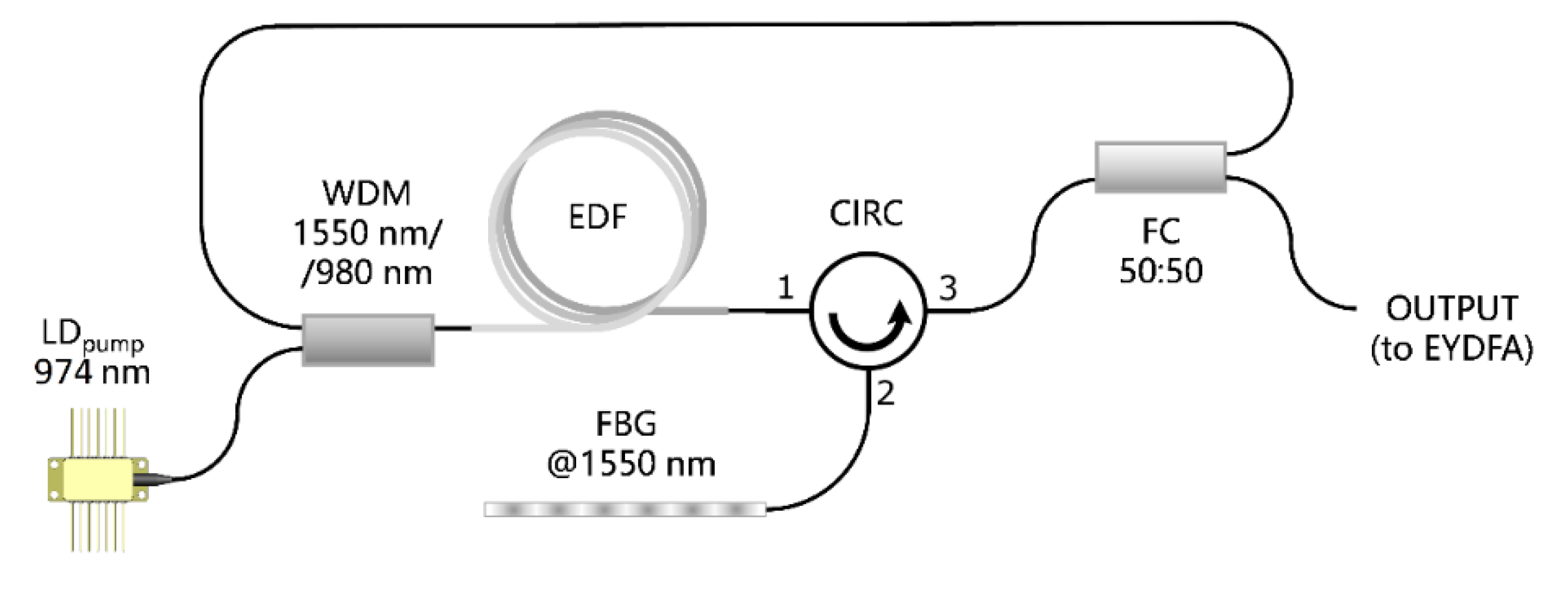

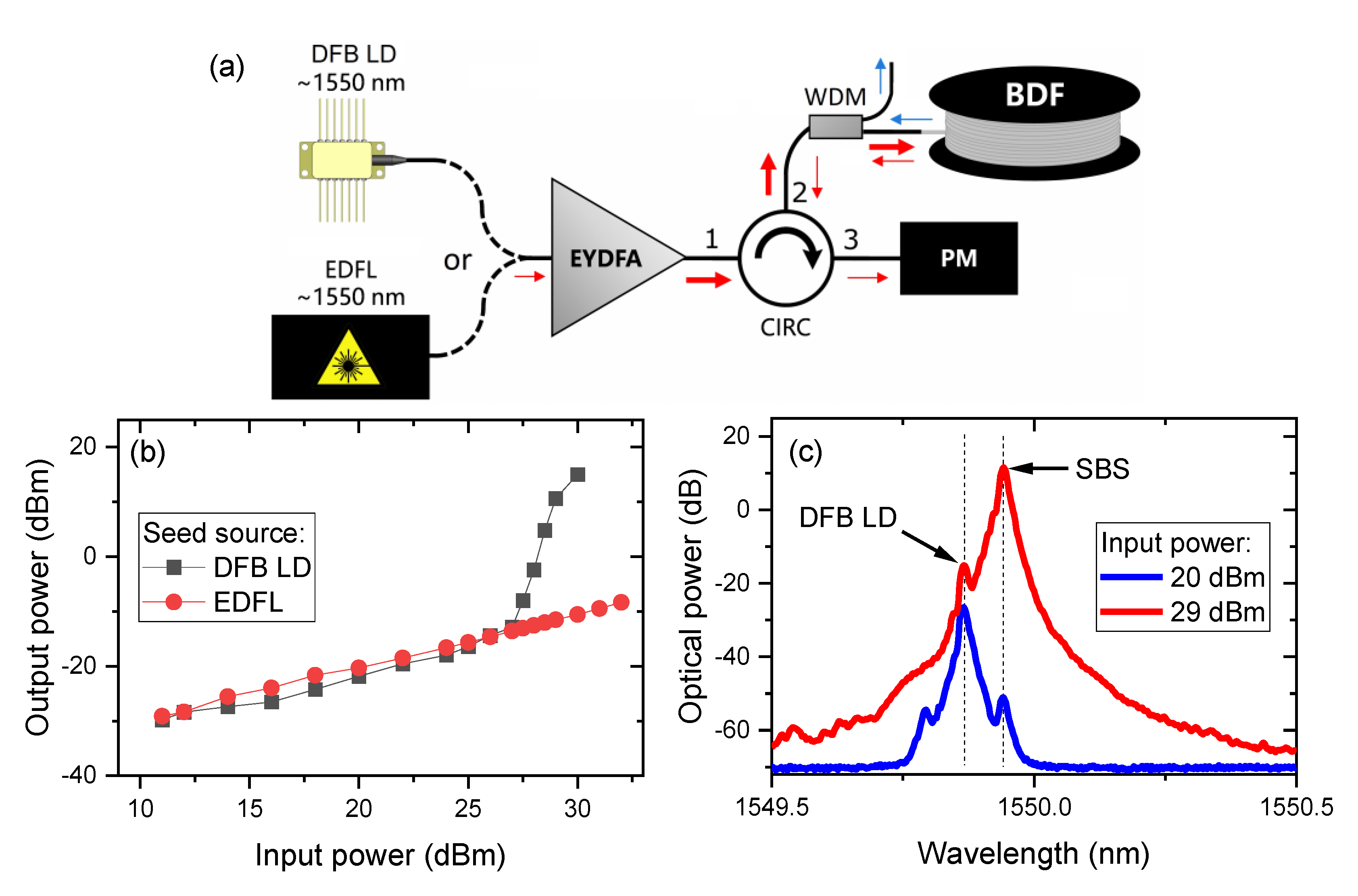

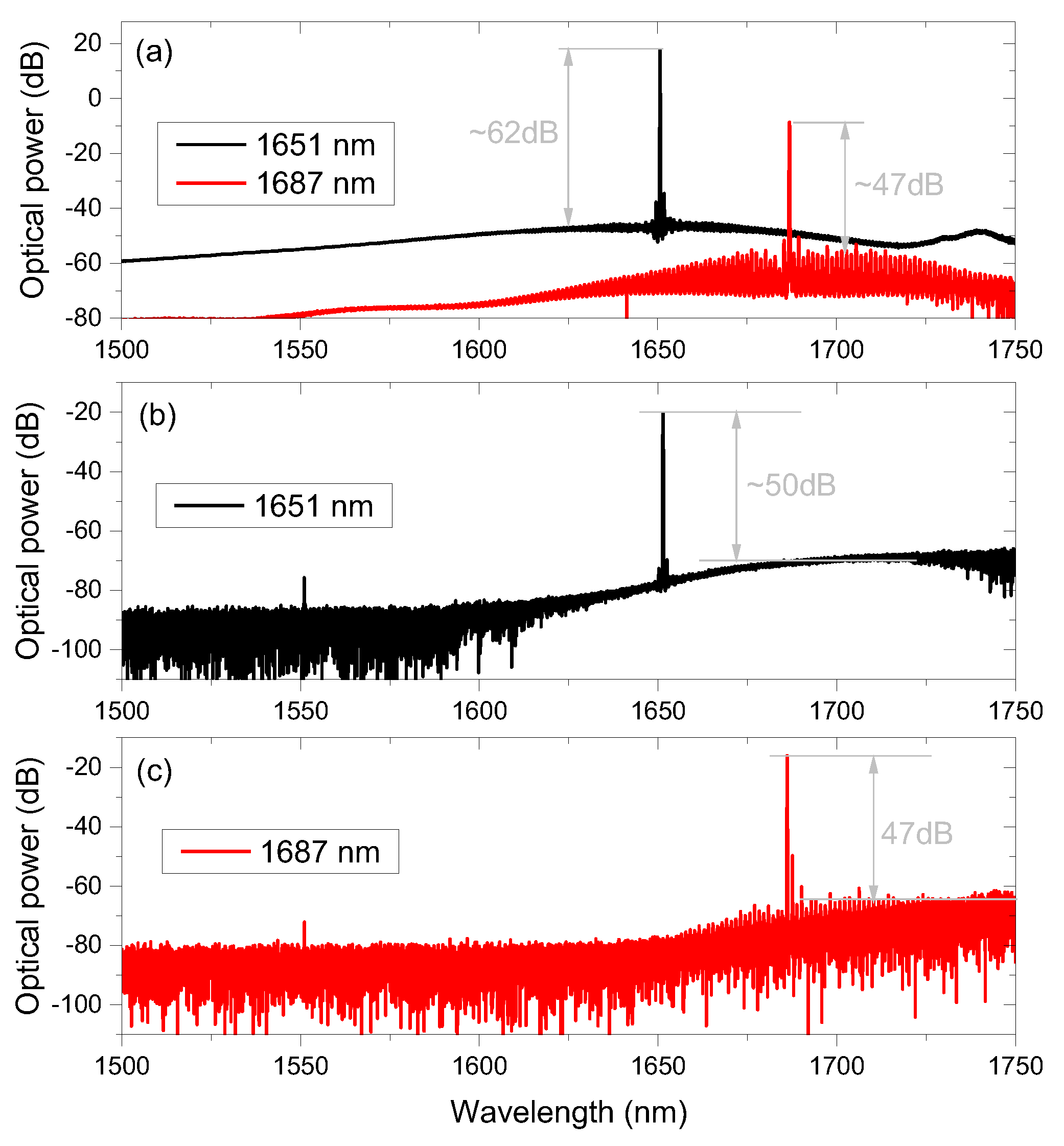
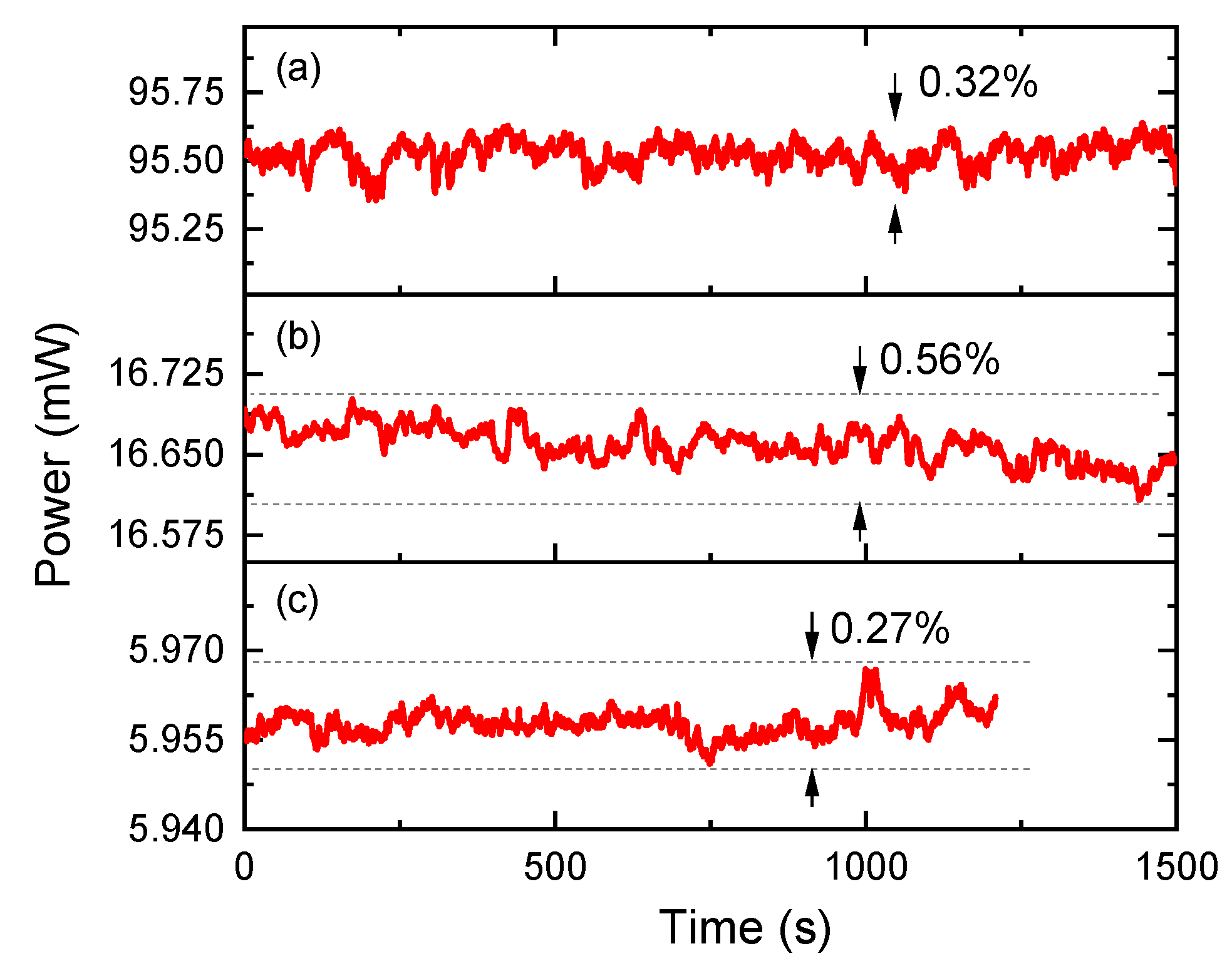

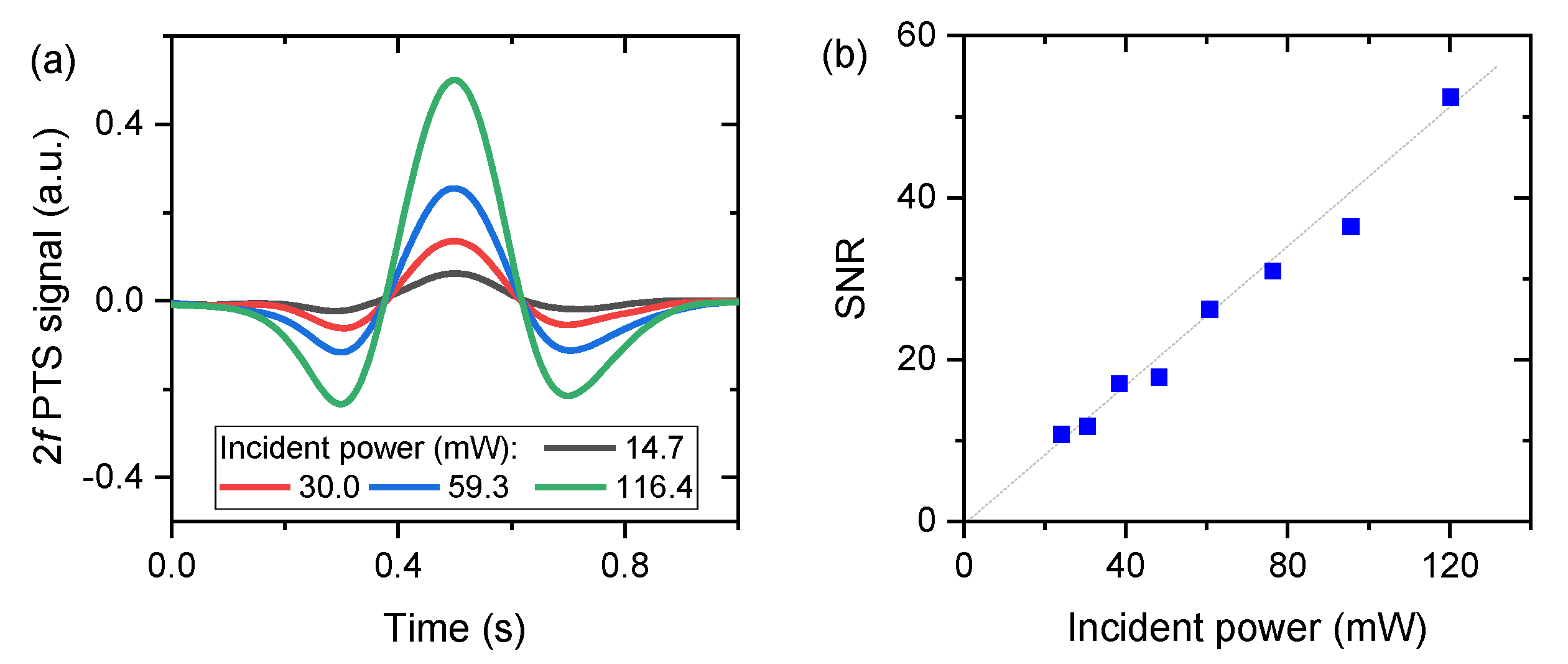
| Ref. | Fiber Type | Fiber Length | Pump Power | Small Signal Gain | Output Power |
|---|---|---|---|---|---|
| @1650 nm | @1650 nm | ||||
| [7] | Al/Tm-doped | 5 m | 37 dBm | 8 dB | 8 dBm |
| [8] | Ge/Tm-doped | 4.5 m | 36.9 dBm | 18.7 dB | 15 dBm |
| [17] | Ge/Bi-doped | 50 m | 24.77 dBm | ~5 dB | 10 dBm |
| (@1680 nm) | |||||
| This work | Ge/Bi-doped | 90 m | 32 dBm | 18 dB | 22.1 dBm |
Publisher’s Note: MDPI stays neutral with regard to jurisdictional claims in published maps and institutional affiliations. |
© 2020 by the authors. Licensee MDPI, Basel, Switzerland. This article is an open access article distributed under the terms and conditions of the Creative Commons Attribution (CC BY) license (http://creativecommons.org/licenses/by/4.0/).
Share and Cite
Gomółka, G.; Krajewska, M.; Kaleta, M.; Khegai, A.M.; Alyshev, S.V.; Lobanov, A.S.; Firstov, S.V.; Nikodem, M. Operation of a Single-Frequency Bismuth-Doped Fiber Power Amplifier near 1.65 µm. Photonics 2020, 7, 128. https://doi.org/10.3390/photonics7040128
Gomółka G, Krajewska M, Kaleta M, Khegai AM, Alyshev SV, Lobanov AS, Firstov SV, Nikodem M. Operation of a Single-Frequency Bismuth-Doped Fiber Power Amplifier near 1.65 µm. Photonics. 2020; 7(4):128. https://doi.org/10.3390/photonics7040128
Chicago/Turabian StyleGomółka, Grzegorz, Monika Krajewska, Małgorzata Kaleta, Aleksandr M. Khegai, Sergey V. Alyshev, Aleksey S. Lobanov, Sergei V. Firstov, and Michał Nikodem. 2020. "Operation of a Single-Frequency Bismuth-Doped Fiber Power Amplifier near 1.65 µm" Photonics 7, no. 4: 128. https://doi.org/10.3390/photonics7040128
APA StyleGomółka, G., Krajewska, M., Kaleta, M., Khegai, A. M., Alyshev, S. V., Lobanov, A. S., Firstov, S. V., & Nikodem, M. (2020). Operation of a Single-Frequency Bismuth-Doped Fiber Power Amplifier near 1.65 µm. Photonics, 7(4), 128. https://doi.org/10.3390/photonics7040128




